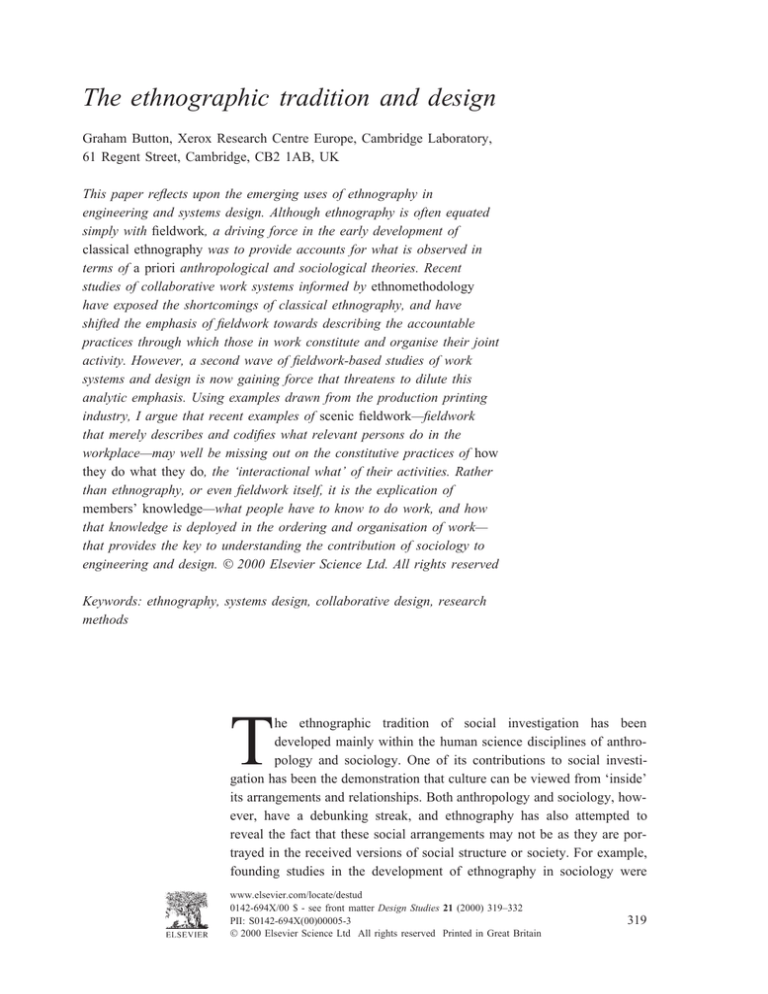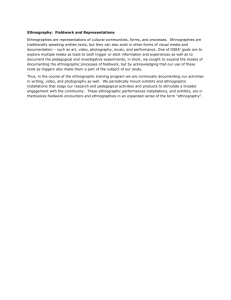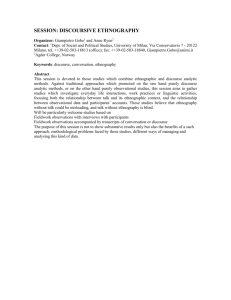
The ethnographic tradition and design
Graham Button, Xerox Research Centre Europe, Cambridge Laboratory,
61 Regent Street, Cambridge, CB2 1AB, UK
This paper reflects upon the emerging uses of ethnography in
engineering and systems design. Although ethnography is often equated
simply with fieldwork, a driving force in the early development of
classical ethnography was to provide accounts for what is observed in
terms of a priori anthropological and sociological theories. Recent
studies of collaborative work systems informed by ethnomethodology
have exposed the shortcomings of classical ethnography, and have
shifted the emphasis of fieldwork towards describing the accountable
practices through which those in work constitute and organise their joint
activity. However, a second wave of fieldwork-based studies of work
systems and design is now gaining force that threatens to dilute this
analytic emphasis. Using examples drawn from the production printing
industry, I argue that recent examples of scenic fieldwork—fieldwork
that merely describes and codifies what relevant persons do in the
workplace—may well be missing out on the constitutive practices of how
they do what they do, the ‘interactional what’ of their activities. Rather
than ethnography, or even fieldwork itself, it is the explication of
members’ knowledge—what people have to know to do work, and how
that knowledge is deployed in the ordering and organisation of work—
that provides the key to understanding the contribution of sociology to
engineering and design. 2000 Elsevier Science Ltd. All rights reserved
Keywords: ethnography, systems design, collaborative design, research
methods
T
he ethnographic tradition of social investigation has been
developed mainly within the human science disciplines of anthropology and sociology. One of its contributions to social investigation has been the demonstration that culture can be viewed from ‘inside’
its arrangements and relationships. Both anthropology and sociology, however, have a debunking streak, and ethnography has also attempted to
reveal the fact that these social arrangements may not be as they are portrayed in the received versions of social structure or society. For example,
founding studies in the development of ethnography in sociology were
www.elsevier.com/locate/destud
0142-694X/00 $ - see front matter Design Studies 21 (2000) 319–332
PII: S0142-694X(00)00005-3
2000 Elsevier Science Ltd All rights reserved Printed in Great Britain
319
1 Hughes, E C The Sociological Eye: Selected Papers Transaction Publishers, New Brunswick (1993)
2 Anderson, R J, Button, G
and Sharrock, W W ‘Supporting
the design process within an
organisational context’ in G de
Michelis, C Simone and K
Schmidt (eds) Proceedings of
the Third Conference on Computer-Supported
Co-operative
Work-ECSCW ’93 Kluwer, Dordretch (1993) pp 47–59
3 Anderson, R J, Button, G
and Sharrock, W W ‘Getting the
design job done: notes on the
social organisation of technical
work’ Journal Of Intelligent Systems Vol 3 (1993) pp 319–344
4 Bucciarelli, L L Designing
Engineers MIT Press, Cambridge, Mass (1994)
5 Button, G and Sharrock, W
W ‘Occasioned practices in the
work of software engineers’ in M
Jirotka, and J A Goguen (eds)
Requirement Engineering Academic Press, New York (1994)
pp 217–240.
6 Button, G and Sharrock, W
W ‘Practices in the work of
ordering software development’
in A Firth (ed) Negotiations In
The Workplace: Studies of Language in the Workplace Pergamon New York, (1995) pp 159–
180
7 Button, G and Sharrock, W
W ‘Project work: the organisation
of collaborative design and
development in software engineering’ Computer Supported Cooperative Work (CSCW), Vol 5
(1997)
8 Button, G and Sharrock, W
W ‘The production of order and
the order of production’ in J
Hughes, W Prinz, T Rodden
and K Schmidt (eds) Proceedings of the Fifth European Conference on Computer Supported
Cooperative Work Kluwer, Dordrecht (1997) pp 1–16
9 Button, G and Sharrock,
WW
‘The
organisational
accountability of technological
work’ Social Studies of Science
Vol 28 (1998) pp 73–102
10 Grinter, R ‘Using a configuration management tool to
co-ordinate software development’ in N Comstock, and C
Ellis (eds) Proceedings of ACM
Conference on Organisational
Computing Systems ACM Press,
(1995) pp 168–177
11 Grinter, R ‘Supporting
articulation work using configuration management systems’
320
often concerned with groups considered to be different from the rest of
society—bums, hobos, hookers, pimps, and gamblers—and conducted in
odd locations—the street, public toilets, whore houses, and mental institutions. Received wisdom was that these marginal groups lead desperate,
chaotic lives, outside of the ordered and regulated ways of the rest of
society. However, ethnographic studies succeeded in revealing just how
regulated, mundane and ordinary were the lives of people in these groups.
In the light of what for some will be the tawdry origins of ethnography in
sociology, readers of Design Studies might well ask: “what possible interest could such a tradition of research have for me?”
Part of the answer to this question resides in the way in which the ethnographic tradition in sociology has also involved the study of work. As early
as the mid-1930s Everett Hughes, drawing on his anthropological training,
initiated an ethnographically-based sociology of work, subjecting work,
occupations, and the professions to sociological scrutiny1. Since then a
considerable body of literature has developed that depicts various work
related themes such as the value of work, changing perceptions of work,
the management of social relations, and the formal and informal structures
of work. Although the study of work is not pursued as ardently within
sociology as once it was, within recent years there have been a number of
studies that have used ethnographic fieldwork techniques to study work
domains associated with the so-called generation of knowledge: science
and technology. A number of these have concentrated upon engineering
and design work2–13. In addition to these, there have also been a number
of fieldwork studies of work domains unrelated to engineering and design,
but which have been undertaken for the purpose of informing the design
and engineering communities as they develop computer systems to be used
in those domains of work14–16.
There are many aspects of these recent developments that resonate with
the ethnographic tradition in anthropology and sociology, especially the
use of fieldwork techniques. However, there are also some ways in which
these recent developments display serious departures from that tradition.
First, some have distinct motivations which differ from those that have
informed the ethnographic tradition. This tradition, as it has been played
out in sociology, was primarily concerned with informing other sociologists, and to some extent, those who create and implement social policy.
In this respect, ethnography was theoretically, methodologically and politically motivated. However, a characteristic of some recent ethnographies
of design is that they have clearly practical goals, and often are carried
out on behalf of the workgroups under study, or particularly in the area of
computer-supported collaborative work (CSCW), to inform systems
Design Studies Vol 21 No 4 July 2000
designers hoping to introduce computer technology into those work
domains. As some of the papers in this special issue suggest, studying
engineering and design work may also be used to inform the very organisation of that work.
Computer Supported Co-operative Work: The Journal of Collaborative Computing Vol 5 (1996)
pp 447–465
12 Grinter, R ‘Doing software
development: occasions for
automation and formalisation’ in
J Hughes, W Prinz, T Rodden
and K Schmidt (eds) Proceedings of the Fifth European Conference on Computer Supported
Co-operative Work Kluwer, Dordrecht (1997) pp 173–188
13 Sharrock, W W and Button, G ‘Engineering investigations: practical sociological
reasoning in the work of engineers’ in G Bowker, L Gasser, S
Leigh and B Turner (eds) Social
Science, Technical Systems and
Co-operative Work Lawrence
Erlbaum, New Jersey (1997)
14 Heath, Luff, Hughes, Randall and Shapiro, in L Bannon,
M Robinson and K Schmidt
(eds) Proceedings of the Second
European Conference on Computer-Supported
Co-operative
Work Kluwer, Dordrecht (1991)
15 Hughes, Randall and
Shapiro; Bentley, Rodden,
Sawyer, Sommerville, Hughes,
Randall and Shapiro; Luff,
Heath and Greatbatch; Harper,
in J Turner and R, Kraut (eds)
Sharing Perspectives CSCW ’92
ACM Press (1992)
16 Anderson, Button and
Sharrock; Heath, Jirotka, Luff
and Hindmarsh; Murray in G
de Michelis, C Simone and K
Schmidt (eds) Proceedings of
the Third European Conference
on Computer Supported Cooperative Work Kluwer, Dortrecht (1993)
17 Malinowski, B Argonauts of
the Western Pacific Routledge,
London (1967)
A second divergence between the recent studies associated with engineering and design is that the disciplinary background of those undertaking the
studies has widened beyond anthropology and sociology. Although the
initial ethnographic orientation in sociology developed many themes in
common with social psychology, mainstream psychology has not trodden
the ethnographic path. Recent ethnographic studies, however, have not only
been undertaken by sociologists and anthropologists but also by psychologists, and interestingly some computer scientists have also engaged in this
type of research. The third divergence is that a great deal of this work,
though certainly by no means all of it, is not in fact informed by an ethnographic tradition at all but by a completely distinct and very small domain
of sociology: ethnomethodology.
In this paper, I want to reflect upon one of the new emergent uses of
ethnography in engineering and design. In the main, the other papers in
this special issue focus upon the study of engineering design as work itself,
with the intentions of contributing to the organisation of that work either
through the design of support tools, or through the design of the work
process. This paper, however, is set slightly apart from the others in that
it focuses upon what it is to work with designers in the development of
the object of their design and engineering, in this case the use of ethnography in the design of software systems. In considering this difference, I will
attempt to extrapolate some of the arguments so as to reflect upon the
ambitions of those who are studying engineers and designers. I want first,
though, to consider the ethnographic tradition in the human sciences in
more detail.
1
An ethnographic tradition
A first point that needs to be established is that when the term ethnography
is being bandied about either in the study of engineering and design work,
or with respect to the study of work for engineering purposes, it is mainly
being used as a proxy for fieldwork. Often when ethnography is being
explained, heralded, feted, or condemned, the champions or detractors are
not talking or writing about ethnography but about field-work: the ethnographic tradition and what it has involved is an overarching presence,
vaguely felt but never directly confronted in many of these examinations.
The founding of ethnography by the anthropologist Malinowski17 certainly
involved fieldwork techniques. Thus his foundational series of studies of
The ethnographic tradition and design
321
the Trobriand islanders involved him in living amongst them, learning their
language, participating in their customs and collecting first hand recollections of their way of life, including their myths, magical incantations, history, folk-lore and stories. This immersion in the society or the tribe pioneered by Malinowski became a prerequisite for most subsequent
anthropological studies, and anthropology established field work techniques as part of the methodological menagerie that makes up the
human sciences.
Anderson18, however, makes the point that there is more to ethnography
than fieldwork: it also involves an ‘analytic mentality’. Thus the object of
ethnography, as it was established by Malinowski, is not just a matter of
bringing back the myths of a culture, its folk-lore and the descriptions of
activities or ceremonies that take place within it, and then presenting them
in some literal fashion in terms of, for example, a vernacular description
of what the anthropologist has witnessed or was told. Rather than providing
a literal rendition of such matters, the anthropologist was involved in constructing an account or an interpretation of the role they play in the life
of the tribe or the society. Thus Anderson reminds us that Malinowski
does not simply describe, as he witnessed it and had told to him, the ‘Kula
Ring’. Instead, he explains it in terms of its role in Trobriander society:
Kula functions as a method of social cohesion by promoting social integration. In this explanation, Malinowski is rendering a functionalist account
of society, a social theory that was also being deployed by sociologists in
accounts of their own societies, but without reference to fieldwork. Ethnography, as established by Malinowski and practised by a generation of
anthropologists, consequently involves collecting ‘data’ about a collectivity
through first hand participation in it, and then organising this data in terms
of a social theory, in Malinowski’s case, functionalism.
18 Anderson, R J ‘Work, ethnography and system design’ in
The
Encyclopaedia
of
MicroComputing (1996)
322
A driving force in the development of ethnography in anthropology has
thus been to provide explanatory frameworks that will account for what
is observed. This, however, gives a cast to observation. Ethnography in
anthropology is not a two step process, the anthropologist first describing
what he or she witnesses, and then separately offering an explanation of
this information. The reason for this is that the explanatory framework
conditions the observation or the description in the first place. Thus Malinowski’s description of Kula is marbled through with the terms of his
explanatory framework. It is described from the point of view of social
cohesion, not from the point of view of the islanders themselves. How
the Trobrianders apply the category Kula to their own activities is not
Malinowski’s concern: his concern is with the anthropological application
of the concept of social cohesion to Kula.
Design Studies Vol 21 No 4 July 2000
2
Problems in sociological description
A second question that could then be raised in the context of the design
and engineering community concerns the interest that a theory of society
can have when applied to them, or to other occupational communities with
which they may be professionally engaged. However, though this may be
a legitimate question, there is one that as a sociologist I would want to ask
first. This concerns the extent to which the generation of and application of
theories of society to observations about the workings of society is the
appropriate way in which sociology, itself, should proceed. A problem can
be raised with the types of sociology that are conducted by applying
theories of society to particular witnessed activities or groups, a problem
that goes to the very heart of what it is to engage in ‘professional’ social
description or inquiry. It is obviously not possible, nor relevant; to fully
explore the dimensions or the consequences of this problem here, but
allusion to it is important for examining the relationship between ethnography and design. The problem has two dimensions to it. First, the relationship between descriptions of social action produced by human scientists
and the descriptions produced by those who perform them, and second,
the loss of the phenomena.
2.1
Professional and lay sociology
In Malinowski’s account of The Kula Ring we are presented with a professional description of social activity: The Kula Ring is an exercise in
social solidarity. However, if we were to ask the Trobrianders what it is
they are doing it is highly unlikely, even if Malinowski were correct, that
they would answer in this fashion. Perhaps more relevant for present concerns is the fact that within the humans sciences there is, following Heidegger, a general move to regard technology and technologists in a sceptical
light. Thus, technologists are regarded as agents of power. However, if a
particular engineer or group of engineers were asked in the course of their
work what they were engaged in doing, it is highly improbable that they
would answer in this fashion, but rather would describe the work task in
hand. Thus, for example, the engineering designer on a project developing
a new digital printer may well respond to such an enquiry by describing
how he was, at that moment, generating a representation of the machine’s
architecture. It would be highly remarkable if he were to respond with the
description of what he was doing as ‘contributing to world domination’,
unless he were kidding the poor sociologist observing him. The point is
not that he is not contributing to world domination in doing his work—he
may or may not be. However, the description that he is contributing to
world domination is dependant upon, yet does not make visible, the ‘lay’
description of his activities as work tasks. This description remains absent
The ethnographic tradition and design
323
from the human science account, yet is presupposed by it. The social
science account is, in this sense, a secondary account.
In the science and engineering disciplines, the scientist and the engineer
can produce their accounts of matter in motion free of these kinds of worries. They need not concern themselves with the fact that the subject matter
of their endeavours may dispute their accounts: molecules simply do not
talk back. In the human sciences, however, members of society have wellorganised descriptions of their own doings. Traditionally, the human
sciences have proceeded by regarding these descriptions as truncated, partial, ad hoc, ideological, mere common sense, or in some other way
deficient when set against the human scientists’ accounts, which are
deemed superior in kind due to their theoretical and methodological rigour.
However, the terms of sociological description are very much the terms of
common-sense description. Thus, to instance a founding study of sociology, Durkheim’s examination of suicide19, which was an attempt to
establish that the scientific frame of reference could be applied not only
to matter in motion but also to social doings, actually embodies a common
sense understanding of suicide, in spite of Durheim’s intentions. Although
he relates suicide to social cohesion, as opposed to states of mind, climatic
conditions, or other presumed causes of suicide prevalent at the time he
was writing, he nevertheless uses the same understanding of suicide that
is common in society. The reason for this is that he draws his data of the
frequency of suicide from statistics produced by the coroner’s office, and
these statistics had been generated through the common-sense reasoning
that was involved in applying the category ‘suicide’ to a particular case.
Despite the exotic appearance of the task, the coroner employs commonsense reasoning in dealing with a mundane matter of assigning a category
from a range of categories to the case in hand. After all, dead bodies are
not found with labels on them. It is the work of the coroner to provide for
the application of one of a range of labels to the case in hand. Has the
dead body been produced through suicide, murder, misadventure, accident?
The coroner must assemble and organise the application of one of these
labels. Thus the social fact, the very facticity of the suicide, is not given,
it has been produced through a social process. The terms of the professional
account are, consequently, dependent upon the common-sense landscape:
they are secondary descriptions.
19 Durkheim, E Suicide Lowe
and Brydone, London (1957)
20 Sacks, H ‘Sociological
description’ Berkley Journal of
Sociology Vol 8 (1964) pp 1–16
324
Harvey Sacks20 has proposed that the more interesting issue for sociology
might be the investigation of how primary descriptions are assembled, how
the category of suicide, for example, is assembled and deployed in local
circumstances, rather than placing a sociological veneer over those activities. “An investigation of how it is that a decision that a suicide occurred
Design Studies Vol 21 No 4 July 2000
is assembled, and an investigation of how an object must be conceived in
order to talk of it as ‘committing suicide’, these are the preliminary problems for sociology. Having produced procedural descriptions of the
assembly of a suicide classification it may turn out that it is the category
and the methodology for applying it that constitutes the interesting sociological problems20.” Sacks’ proposal here is very much in keeping with
the domain of sociology known as ethnomethodology, which was founded
by Harold Garfinkel21. Despite the similarity in name, ethnomethodology
owes nothing to classical ethnography, and the two should not be confused.
Ethnomethodology is a radical re-specification of the foundations of the
human sciences, foundations shared by the classical ethnographers of
anthropology. It shifts the emphasis away from the production of sociological accounts and theories of social doings to an emphasis upon the description of the accountable practices involved in the production of naturally
organised phenomena22.
Thus ethnography as a mode of social investigation, although seemingly
articulating the arrangements of society from within, in fact demotes those
as the primary object of concern in favour of secondary description. On
this argument, classical ethnography as the application of social theories
is then a dubious exercise. The interest that designers or engineers could
have in ethnography is therefore put into question by what I am contending
is the very problematic status and value that ethnography has for the human
sciences themselves.
2.2
21 Garfinkel, H Studies in
Ethnomethodology
PrencticeHall, Englewood Cliffs NJ (1967)
22 Heritage, J C Garfinkel and
Ethnomethodology Polity Press,
Cambridge (1984)
The vanishing phenomenon
What, then, of the fieldwork that is associated with ethnography? To a very
real extent, investigations that currently call themselves ethnographies are
not cast in the mode of classical anthropological ethnographies, as they do
not necessarily propose the application of a favoured social theory to the
particular group or work domain under study. However, the alternative to
theorising proposed by Garfinkel and Sacks in the development of ethnomethodology could be based upon the fieldwork techniques associated with
ethnography. Materials gathered from relevant settings, such as coroners’
courts, could be used to answer the question posed by Sacks as to how
the category of suicide is assembled and applied. Consequently, fieldwork
could be used in the service of a sociology that does not fall foul of the
problems of sociological description that have just been identified with
ethnography. The question of the relevance or interest that ethnography
might have for designers or engineers would be more appropriate and to
the point if it were transformed into a question of the interest or relevance
that fieldwork could have for them. However, even then the issue is clouded
The ethnographic tradition and design
325
by a prior question that arises from the use of fieldwork in the human
sciences.
23 Lynch, M Art and Artefact in
Laboratory Science: A Study of
Shop Work and Shop Talk in a
Research Laboratory Routledge
and Kegan Paul, London (1985)
24 Latour, B and Woolgar, S
Laboratory Life: The Social Construction of Scientific Facts
Sage, London (1979)
25 Becker, H S Outsiders:
Studies in the Sociology of Deviance The Free Press, New
York (1973)
326
I have been arguing that the use of ethnography in engineering and design
is not the point, and now extend the argument by suggesting also that the
point is also not just about fieldwork. An example drawn from one of the
recent studies of the work of scientists illustrates this. Fieldwork has been
used extensively to develop new understandings of the work of the scientist. However, although drawing on fieldwork materials, the studies that
have emerged radically diverge from one another. Compare two of the
seminal studies of laboratory settings, Mike Lynch’s Art and Artefact in
Laboratory Science23, and Bruno Latour’s and Steve Woolgar’s Laboratory
Life24. Both of these books are based upon materials drawn directly from
observations of scientists working in their laboratories, observing what they
were doing, and by participating in the daily round of the scientists’ working lives. However, if we examine both books it is possible to find radical
differences that show that just doing fieldwork evidently does not yield the
same results. The reason for this divergence, however, is not that the two
studies were examining different laboratory settings, but because they were
done under different analytic auspices. For example, Lynch, operating
under an ethnomethodological influence was attempting to describe the
accountable practices of the lived work of scientists, whilst Latour and
Woolgar were developing a divergent constructionist argument concerning
literary inscription. Although both studies examined the issue of the role
of agreement in science and both gathered instances of agreement from
their observations in the laboratories they were studying, they emphasised
different issues relating to agreement. Latour and Woolgar were interested
in how facticity is a constructed phenomena in reaching agreement, whilst
Lynch was interested in the production of agreement, and the mechanism
through which agreement is organised. I have chosen this example because
on the face of it both books may appear to be very close to one another.
They are both based upon fieldwork, all the investigators engaged in participatory observation, and they both examine the same type of work site.
Yet because their analytic orientations were divergent, then no matter that
they may have used the same method, their analyses are of a different
order with radically and analytically consequential differences.
The differences could have been predicted from remarks made by Harold
Garfinkel about problems associated with some of the early ethnographies
of work. One of the classic and influential ethnographies of work is a
fieldwork study of jazz musicians, conducted by Howard Becker25. He
gives a very detailed account of their working, based upon direct observation and participation in the daily round of the jazz musician. He fur-
Design Studies Vol 21 No 4 July 2000
nishes intimate information on the sort of music they play, the way they
differentiate themselves from the rest of society—‘the squares’—their habits, clothes, lifestyle, and the rest. However, in all the wealth of detail there
is no account of how they make music together, of the interactional and
improvisational ‘work’ of playing together. Garfinkel acknowledges an
observation of Sacks’, which is that studies of occupation miss the interactional ‘what’ of the particular occupation studied. As Lynch put it: “studies
of bureaucratic case workers ‘miss’ how such officials constitute the specifications of a ‘case’ over the course of a series of interactions with a stream
of clients; studies in medical sociology ‘miss’ how diagnostic categories
are constituted during clinical encounters; and studies of the military ‘miss’
just how stable ranks and lines of communication are articulated in and as
interactional work26.”
Garfinkel’s ethnomethodology proposes a domain of study that is concerned with the ‘missing what’ of the ordered and organised properties of
activities, such as complexes of work activities. Such studies may well
draw on fieldwork, but in as much as other studies miss the essential issue
of the constitution of the work under study, fieldwork is not the point. The
point concerns the analytic auspices that are brought to bear, and whether
they preserve the practices through which those involved in work interactionally pull it off.
3
Design and studies of work
How do these issues play out in the world of design? I want to consider
this question with respect to one domain of software design: collaborative
work systems. It is fair to say that the idea of collaborative software systems has arisen in the CSCW field. It is also fair to say that CSCW originated in a reaction to the dominance of cognitive science in the area of
human-computer interaction, with its emphasis upon individual behaviour
and interface design. CSCW, however, focused less upon individual behaviour and more upon the collaboration: less upon interface design, and more
upon how to support collaboration. CSCW also recognised the fact that
computer technology is very often placed within work settings and organisational contexts within which complex divisions of labour already exist,
and within which work activities are very often highly co-ordinated, and
thus began to focus upon systems to support collaboration at work. Inevitably, it is necessary for the designer of collaborative work systems to gain
some knowledge of the nature of the work that their systems will support.
26 Lynch, M Scientific Practice
and Ordinary Action: Ethnomethodology and Social Studies of
Science Cambridge University
Press, Cambridge (1993)
However, a question arises as to how the designer can gain knowledge
of the nature of that collaboration and work. The Scandinavian school of
participatory design attempted to involve users in the actual design of sys-
The ethnographic tradition and design
327
tems and introduce knowledge about work, organisations, interaction, etc.
into the design process27. At the same time Lucy Suchman, from Xerox
PARC, emphasised in her critique of AI and cognition the idea of work
practice as a resource in the design of systems to support work and interaction28. Both developments set the stage for the participation of sociologists
interested in the naturalistic study of interaction, especially since those
interactions and that work often involved computer technology. The relevance of a sociological participation was further underscored by the fact
that studies of work often furnished evidence of the problematic design of
a system, describing how the system detrimentally impacted peoples’ work
activities and even showing that a system had to be worked around. It is
now the case that no CSCW conference seems to be complete without
a naturalistic, observational study of work. Although they often describe
themselves as ethnographic and while they certainly use fieldwork, these
studies of work are not in fact ethnographic in classical terms, and are
done primarily under the analytic auspices of ethnomethodology. The first
wave of the relationship between ‘studies of work’ and design in CSCW
has then broken. A very small band of sociologists, mainly adopting an
ethnomethodological orientation, and a number of CSCW practitioners who
were probably unconcerned with the complexion of the sociologists, just
the practical outcomes of their investigations, have recognised that they
can have a mutual interest in exploring the relationship between fieldwork
based studies of work and systems design.
However, a second wave is now gaining force. A distinctive feature of this
is that a number of CSCW practitioners are engaging in studies of work
themselves, not just appreciating the studies produced by sociologists.
These initiatives are, however, in danger of diluting the initial thrust of
sociological studies of work for design purposes because although engaging in fieldwork may be important, it is not enough. Fieldwork may provide
data about the organisation of work and collaboration at work, and about
the use of technology at work. However, the telling issue is how that data
is analytically worked. If the first wave could be described as analytic
fieldwork, using data gleaned from fieldwork as material for analysis, the
second wave could be described as scenic fieldwork, recording what is to
be seen.
27 Greenbaum, J and Kyng,
M Design at Work Lawrence
Erlbaum Associates, Hillsdale
NJ (1991)
28 Suchman, L Plans and
Situated Action: The Problem of
Human-Machine
Communication. Cambridge University Press, Cambridge (1987)
328
4
The ‘interactional what’ in production print
scheduling
An example may be in order. Fieldwork-based studies of production printing reveal that production is managed by a number of people interacting
with one another around organisational artefacts such as a production list,
Design Studies Vol 21 No 4 July 2000
a scheduling board, work tickets and the like29. It would be perfectly understandable to produce fieldwork-based descriptions of the work of production printing describing these objects and the fact that they are being
used, even how they are used. This sort of description may depend deeply
upon the fieldwork, and may be of practical use in the design of production
management systems. Thus it is possible to see that production management systems for the print industry available in the market place today are
based upon an understanding of production management in commercial
printers. Many of these products incorporate electronic representations of
the objects that can be found in production settings, objects that fieldwork
would bring to attention. The manufacturers of these systems could even
claim to have improved upon them by, for example, automating various
processes. Thus the scheduling tools on these systems can automatically
schedule a job and be used to quickly run different production scenarios.
However, fieldwork that merely describes what relevant persons do may
well be missing out on the constitutive practices of how they do what they
do, the ‘interactional what’ of their complexes of action. Thus, if we were
to use as a starting point of enquiry the fact that managers in the print
factory manipulate various objects, such as scheduling boards, and asked
the question ‘what are they doing in using these objects?’ we might begin
to see important practices involved in their work that otherwise would
remain concealed to us. If we only described what they did, we might well
only be touching the surface of their work endeavours, the details of which
would remain known only to them, or to others who could do their work.
If we do ask these questions then we begin to see that these objects are
used as tools in the situated achievement of a production order that is
responsive to the contingencies of print production, such as keeping all
machines running and hitting agreed deadlines. Certainly, scheduling
boards are used to work out answers to the calculations involved in this,
and the level of automation offered by current products may well be of
value.
29 Button, G and Sharrock,
W W ‘The production of order
and the order of production’ in J
Hughes, W Prinz, T Rodden
and K Schmidt (eds) Proceedings of the Fifth European Conference on Computer Supported
Co-operative Work Kluwer, Dordrecht (1997) pp 1–16
However, it is not the manipulation of data that is consequential to those
involved in using the scheduling board to plan production. On the surface
it might appear so, and current systems inevitably assume that it is. Current
systems are really little more than databases and methods of presenting the
data. What is a consequential feature for those that use scheduling boards
is not the ability to grind through production data. Rather, it is that relevant
personnel can use them to fix a picture of the production status at a glance.
Should a printing press go down, as they often do, a quick glance at the
scheduling board reveals in a rough and ready way—but a way that is
The ethnographic tradition and design
329
perfectly adequate for participants’ purposes—what will have to be contended with. The scheduling board, as well as other objects, can thus be
used as ways of making the order of the work visible at-a-glance. In this
respect, it is not inconsequential for its use that the visually available features of the medium are emphasised. Scheduling boards tend to be large,
colourful, often involving paper. The material composition of the object is
the consequential characteristic of its utility in working a production calculus, not its ability to run calculations. In this respect systems that emphasise
the numerical capabilities of scheduling boards would, and do, miss essential requirements. It may be that systems that support the viewing of forward loading boards may be of more value than systems that automate
them. Scenic fieldwork may be unable to reveal this requirement.
Overall, I am not arguing that fieldwork can only be the preserve of the
sociologist and that designers and CSCW practitioners should keep away.
It seems most perplexing that it could ever have been the case that systems
designers or software engineers could ever have thought it unnecessary to
observe first hand the work they were attempting to support. It is sensible
to urge designers to take some time to go ‘into the field’. However, as I
have argued, this should involve the caveat of going into the field under
particular analytic auspices. I would not, however, argue that designers
should first train as ethnomethodologists. Rather, a division of labour
between the designer and the work analyst is in order. What this can
amount to is a matter to be worked out in practice for particular development undertakings. There seems little point in being prescriptive, and we
should really consider this division of labour as a framework within which
design and work studies can collaborate. Thus I am offering the suggestion
that ethnography can be trailed into the world of design in a harder fashion
than our enthusiasm currently permits. It is not classical ethnography that
is the remedy here: indeed I am sceptical of classical ethnography in and
of itself. Much more relevant is the use of fieldwork, but even here I
believe we need to be more rigorous, demanding not merely scenic depictions of settings and doings, but analytic explications of how activities are
done and ordered. Analytic explications must reference what Garfinkel
terms members’ knowledge: what people have to know, and how that
knowledge is deployed in the ordering and organisation of their work. I
believe it is the explication of members’ knowledge for the purposes of
design that is the point of collaboration between design and sociology in
CSCW, certainly not ethnography, and not merely fieldwork.
5
Members’ knowledge
How do these issues translate to the concerns articulated in other papers
in this special issue, where the purpose of working with engineers is to
330
Design Studies Vol 21 No 4 July 2000
contribute to the organisation of their work? In part, the answer turns on
the relationship between the knowledge that people have of their own
activities, and the descriptions that the fieldworker may give of these activities. The arguments presented within ethnomethodology suggest that it is
simply not possible to go beyond members’ knowledge, the knowledge
that persons have of their own doings. We have seen how thinking that it
is possible to do so caused problems within classical ethnography.
The argument that investigations of social life are constrained by members’
knowledge would be unacceptable to many branches of sociology. However, it is an argument that fits the collaborative relationship between studies of work and the design of systems. In many ways, the hallmark of a
strong study of work would be that it contains nothing new for those who
do the work. This is not to say that, as a feature of doing their work, they
naturally provide a commentary on it. They may never have thought about
producing a systematic account of what they do, and the actual explication
of the work may be of little interest to those who do it, and only of interest
to the sociologist. However, for the sociologist’s account of the work to
be systematic, it needs to be recognisable to those who do the work. For
the purposes of designing systems to support their work, such an explication may be exemplary. However, from the point of view of those who
do the work itself, the explications are irrelevant.
So, what does this imply for the engineering community that may be the
subject, rather than the recipient, of ethnographic studies of design work?
There is a strong and a weak version of what can be said. The strong
version is the following: it simply is not possible to tell engineers anything
about how engineering is done and organised that they do not already
know. After all is said and done, it is their knowledge, its organisation,
and the practices of its deployment, that is the object of study. Consequently, even if welcomed by the engineers themselves, studies of their
work will not in practice count in the organisation of engineering work.
While such accounts may provide fascinating insights for sociologists, it
cannot tell the engineers more about engineering and the organisation of
engineering than they already know, for engineering is simply what they
do, and they already know all about what they do. An argument may be
made, though, that an outsider’s point of view can shed light into the dark
corners of engineering work. But as it would be nothing more than a catalyst, any point of view would do, and no special merit could be claimed
for ethnography or ethnographic fieldwork. A further argument might be
that an ethnographic study can act as a mirror, allowing engineers to reflect
on their own practices. If so, then again nothing particular could be claimed
for ethnographic fieldwork, since anything that encouraged reflection
would be in order.
The ethnographic tradition and design
331
We might, however, say that ethnographic fieldwork encourages engineers
to reflect in a certain way, and this is the weak version of the answer.
Laying out the logic of the relationship between various work activities
may occasion an opportunity for them to consider how their work endeavours are supported, organisationally and technologically. For example,
most industrial engineering companies are subject to some sort of product
delivery process (PDP). By studying how this process is applied in practice,
the numerous techniques that engineers have to use to make procedures fit
the varying contingencies and circumstances they face—but which are not
covered by formal PDP descriptions—can be made visible. This is not
news to engineers, but making it explicit through studying their work might
allow managers to articulate product delivery processes more effectively.
For example, if engineers need constantly to refer to the requirements for a
product, then those requirements are better presented online than physically
located in a distant paper archive. By presenting them online, engineers
can make consulting the requirements part and parcel of their work, rather
than an act which forces them to break off from their work. Of course,
another way in which studies of engineering work may be of value to
engineers is to treat the engineering community in the same way as do
studies of work in the CSCW field; bringing an understanding of the engineering work into the design and development of engineering support systems. But, this is clearly a matter for further consideration.
332
Design Studies Vol 21 No 4 July 2000









